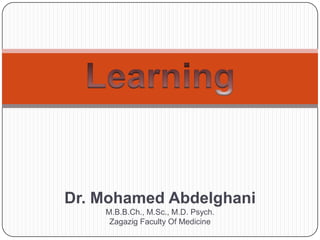
Learning for Undergraduates
- 1. Dr. Mohamed Abdelghani M.B.B.Ch., M.Sc., M.D. Psych. Zagazig Faculty Of Medicine
- 2. DEFINITION A relatively permanent change in behavior brought about by experience
- 3. The most important types of learning are: 1) Classical conditioning 2) Operant conditioning 3) Cognitive Learning Latent learning Social (observational) learning
- 4. Classical Conditioning A previously neutral stimulus elicits a response through its association with a stimulus that naturally brings about the response. Once an association had been made between the two stimuli, the “conditioned stim.” alone could lead to a response.
- 5. Before conditioning (UCS) (UCR) Food salivation CS+UCS Sound + food UCR salivation After conditioning (CS) alone (CR) Sound alone salivation
- 6. Other related definitions Extinction: Unlearning what we have learned. It occurs when a previously conditioned response decreases in frequency and eventually disappears. Spontaneous recovery: Reappearance of a previously extinguished response after a period of time during which the conditioned stimulus has been absent. Stimulus generalization: Response to a stimulus that is similar to the original conditioned stimulus. The great similarity between the two stimuli increases the likelihood of generalization. Stimulus discrimination: Process by which an organism learns to differentiate among stimuli, restricting its response to one in particular.
- 7. Clinical Applications of classical conditioning 1) Emotional response: o Emotional responses may be learned through classical conditioning. o 11-month old infant named Albert 2) Behavior therapy: A. Systematic desensitization: “developed by Wolpe”. B. Addiction to alcohol: “apomorphine”.
- 8. Operant Conditioning It describes learning in which a voluntary response is strengthened or weakened, depending on its positive or negative consequences
- 9. Comparison between Classical and operant conditioning Classical conditioning Stimulus Response Operant conditioning a) A specific event, e.g. a light flash. a) Not a specific event. b) Briefly presented. b) Longer-lasting situation. a) Variable, may be learned in a a) Specific (usually a reflex or sequence (or chain of behaviors) innate reaction to a situation, e.g. so that the end result is attainment limb flexion or salivation) of a desired goal. b) Involuntary (determined by the b) Voluntary (not so closely unconditioned stimulus) determined by the nature of stimulus) Does not depend on the response (i.e., if it always presented regardless of what the organism Reinforcement does, e.g. the meat is given to the dog whether the dog salivated or not). Reinforcement is contingent upon what the learner does. (If the leaner does the 'right' thing, it is reinforced, otherwise it is not).
- 10. Other related definitions Positive reinforcer: a stimulus added to the environment that leads to an increase in a preceding response. Negative reinforcer: a stimulus that removes something unpleasant from the environment, leading to an increase in the probability that a preceding response will occur again in the future. Punishment: an unpleasant or painful stimulus that decreases the probability that a preceding behavior will occur again.
- 12. I- Programmed learning • An instruction technique in which material to be learned is presented in successive, well- planned steps. • Subjects are expected to respond to a certain problem and then check answer they have given is correct or not. • The answer provides feedback or reinforcement, immediately.
- 13. II-Behavior Therapy: Acceptable responses will be reinforced and unacceptable response will be extinguished. It includes: 1) Shaping 2) Token economy 3) Time-out
- 14. 1) Shaping It is the teaching of a complex behavior by reinforcing successive approximation of the desired activity. A complex desired behavior is broken down into a series of simpler responses. This technique is effective in: Training of autistic children to speak Rehabilitation of physically handicapped Treating phobias.
- 15. 2) Token economy For chronic mental hospital patients. To apply the rules of reinforcement to individual behavior on ward basis. What patients want is the reinforcement, what the staff want them to do is the response and the token is the intermediary.
- 16. 3) Time-out o To isolate the child, who made misbehavior, for a brief period. o "Go to your room" without receiving any positive reinforcement (no dinner, no TV, no phone calls).
- 18. Cognitive learning implies understanding the connection between: Cause and effect Action and the consequences of the action. It includes: 1. Latent learning “Cognitive map” 2. Social learning
- 19. 1) Latent learning It is a type of cognitive learning, in which, a new behavior is acquired but not readily demonstrated until reinforcement is provided for displaying it.
- 20. . Cognitive map A mental representation of spatial locations and directions. People develop cognitive maps of their surroundings, based primarily on particular landmarks.
- 21. 2) Social learning (Observational learning)
- 22. • Social learning theory relies on role modeling identification, and human behavior. • A person can learn by imitating the behavior of another person, but personal factors are involved.
- 23. • Albert Bandura is a major proponent of the social learning school. • Behavior results from the interplay between cognitive and environmental factors. • Persons learn by observing others, intentionally or accidentally. • Modeling is an important component of group therapy in which members of the group learn from one another.
- 25. Personal factors: • • • • • Intelligence Motivation Emotion General health Previous learning Objective factors o Method of learning o Teacher„s role Environmental factors Good lighting Adequate ventilation Noise
